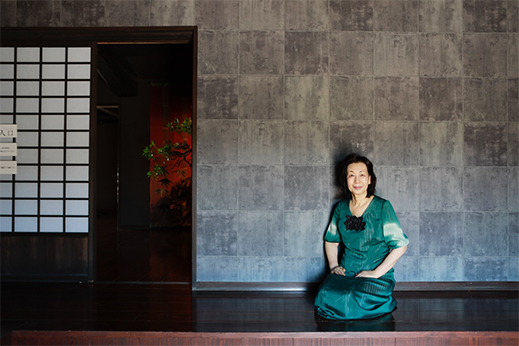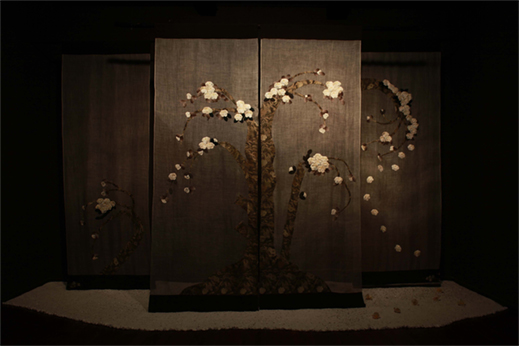 |
Focus features two in-depth reviews each month of fine art, architecture and design exhibitions and events at art museums, galleries and alternative spaces around Japan. The contributors are non-Japanese residents of Japan. |
|
|
 |
 |
 |
Mutsuko Yawatagaki and the Izumo Museum of Quilt Art
Alice Gordenker |
 |
"Pure White Prayer" (Junhaku no inori), 2009, 220 x 280 mm. The image of Mt. Fuji is pieced together from approximately one thousand tiny rectangles of kimono fabric. |
Tucked away amid rice fields in a quiet corner of western Honshu is the only museum in Japan -- and indeed all of Asia -- dedicated to the art of quilting. Located in Izumo, Shimane Prefecture, the Izumo Museum of Quilt Art doesn't present the history of the craft or examples of quilts from different countries. Nor does it offer the work of a changing roster of artists. Rather, it is the very personal creation of Mutsuko Yawatagaki, one of Japan's leading quilters.
Japan boasts a huge variety of traditional crafts, but quilting -- the process of sewing pieces of fabric together to form a larger work -- is an American import, and a relatively recent one at that. As a hobby, quilting was introduced to Japan in the postwar years by Japanese women returning from a few years in the United States. It became popular, however, largely because of an American television program, "Little House on the Prairie," which was broadcast in Japan from 1975 to 1982. Dubbed in Japanese and retitled Daisogen no chiisana ie, its episodes often included scenes of women quilting. Today, there are an estimated three million quilters in Japan, many of whom will tell you it was that show that inspired them to take up the craft. The Tokyo International Quilt Festival, held every January, attracts some 250,000 visitors and is the largest annual quilt event in the world.
 |
|
Quilt artist Mutsuko Yawatagaki at the entrance of her museum. |
Yawatagaki certainly ranks as one of Japan's most famous quilters; her works have been showcased in major exhibitions in both Japan and abroad, and are featured regularly in the pages of needlework magazines. At one point, she had over 100 students coming for regular lessons. In 2006, she was moved to open her own museum after a friend observed that artists are rarely so honored until after their death. "Where's the fun in that?" she quipped. "If I'm going to have a museum, I want to be able to enjoy it while I'm alive."
Exterior view of the museum (top), and an installation (bottom) in a traditional tatami-mat room of quilted fabric mounted as a folding screen work, "Prayer" (Inori), 1999. |
And enjoy it she does, personally producing every exhibition, from the hanging of the quilts to the overall design, which is visually striking at every turn. Housed in a 200-year-old traditional residence, the museum is not large; a typical exhibition will feature only nine or ten of Yawatagaki's works. But each quilt is presented as part of an installation and complemented by imaginative flower arrangements spaced throughout the museum. In a recent exhibition the inner courtyard was filled with a dynamic arrangement of rusty iron pipes sprouting every which way. The end of each tube was topped with a single, perfect yellow chrysanthemum bloom, which was changed by hand every morning.
|
 |
|
|
|
"Red Camellia" (Kanko), 2009. The filled roll of fabric at the bottom is inspired by the padded hem of an uchikake, a bride's wedding kimono.
|
Yawatagaki works almost exclusively with fabric salvaged from antique kimono and obi that are often themselves works of art. Her themes are familiar ones from Japanese art, including dragons, flowers of the seasons, and Mt. Fuji. There are four exhibitions a year, organized around the seasons and, often, a specific color. The current winter exhibition is titled Shiro e no dokei ("Longing for White"). "White is probably the most interesting color," she explained when I visited. "Red, for example, changes drastically when you layer it, which is a frequently used technique in quilting. But if you place white on white, it doesn't change -- you still have white." The kimono fabrics Yawatagaki uses may have woven patterns of auspicious motifs such as tortoises and cranes. "Not only are such fabrics imbued with meaning, but they also change with the light," she said.
For the base material of her quilts, Yawatagaki sometimes uses kaya, which are finely woven mosquito nets made of hemp and other natural fibers. They are hardly produced any more, and prohibitively expensive, but were once a fixture in the sleeping quarters of better homes. Yawatagaki is partial to this vintage fabric because it is feather-weight and admits a good deal of light. She hand-dyes the netting to achieve subtle gradations in color, and when hanging a finished quilt she positions the lighting to throw interesting shadows through the weave.
 |
|
"Celestial Maiden's Hair Ornament (White Camellia)" (Tennyo no kami-kazari [shiro tsubaki]), 2008. The base fabric is hemp mosquito netting. |
About half of the museum's visitors have a specific interest in quilting and come from all over Japan and the world. The rest may stop by out of curiosity when making a trip to see Izumo Taisha, one of Japan's most important shrines, or the Adachi Museum of Art and its famous gardens, or simply to appreciate traditional Japanese aesthetics with a Western twist. Yawatagaki is particularly pleased when people who have no prior experience with kimono visit, because her quilts may provide an introduction to the beauty of kimono. "In repurposing kimono, I am trying to give new life to fabric that is no longer worn and enjoyed. So while I am happy to have my work seen, my hope is that people will not focus solely on the quilts," she said. "I would rather they take in the entire space and feel the contributions of the many artisans who contributed to the creation of each kimono. A kimono is truly an amazing object."
Images courtesy of the Izumo Museum of Quilt Art. |
 |
| Shiro e no dokei ("Longing for White") |
| 29 November 2018 - 26 February 2019 |
| Izumo Museum of Quilt Art |
330 Fukutomi, Hikawa-cho, Izumo, Shimane Prefecture
Phone: 0853-72-7146
Hours: 10 a.m. to 5 p.m.; closed Wednesdays and the third Sunday of each month
Access: The closest airport is Izumo, served by daily direct flights from Tokyo's Haneda Airport and Osaka's Itami Airport. A taxi from Izumo Airport to the museum takes about 10 minutes. By train, take JR's Yakumo Limited Express from Okayama to Izumo (2 hrs 50 mins). A taxi from JR Izumo Station to the museum takes about 30 minutes. |
|
 |
 |
Alice Gordenker
Alice Gordenker is a writer and translator based in Tokyo, where she has lived for more than 20 years. For over a decade, she penned the "So, What the Heck Is That?" column for The Japan Times, providing in-depth reports on everything from industrial safety to traditional talismans. She translates and consults for museums and has a special interest in making Japanese museums more accessible for visitors from other countries. |
|
 |
|